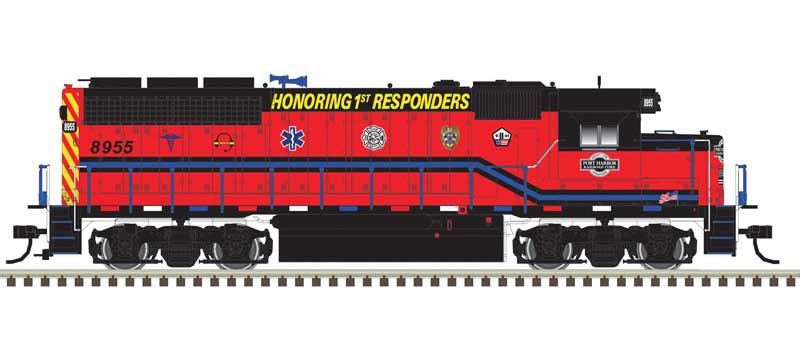The ATLAS Gold 40005286 EMD GP40 is a high - quality N Scale locomotive. It's themed after the Port Harbor #8955 in red, white, blue, and black colors, representing first responders. Please note that pictures might show a different road number. This locomotive is modeled after the Electro Motive Division's 2000 - horsepower GP - 38 diesel from the late 1960s to early 1970s, still in service across North America. The GP - 38 can be recognized by two radiator fans on the long hood and two small exhaust stacks. The GP - 40, produced in the same era, has 3000 horsepower and three full - size radiator fans on the rear of the roof. Key features include directional lighting, walkway safety tread, blackened metal wheels, a Scale Speed™ motor, factory - equipped AccuMate® knuckle couplers, dynamic brakes (as per railroad), and golden - white LEDs. For DCC operation (GOLD LOCOMOTIVES ONLY), it supports all DCC - programming modes, includes RailCom and RailComPlus, has flexible function key mapping, and follows NMRA DCC standards. ESU LokSound features (GOLD LOCOMOTIVES ONLY) offer over 20 sound effects, multiple user - selectable horns, bells, and brake squeals, and manual and automatic notching modes for realistic operation.

Using your ATLAS Gold 40005286 EMD GP40 locomotive is easy. First, make sure your DCC system is set up correctly. You can control the locomotive's speed and direction using your DCC controller. For a more realistic experience, explore the sound effects. You can start the engine, hear the prime mover at different notches, ring the bell, and blow the horn. When it comes to notching, you can choose between manual and automatic modes. If you're new to DCC, start with the automatic mode and switch to manual as you get more comfortable. Here are some important notes. Always handle the locomotive gently to avoid damaging the delicate parts like the couplers and wheels. When cleaning, use a soft, dry cloth to wipe the body. For the wheels, you can use a specialized model train wheel cleaner. Make sure to keep the locomotive in a dry and dust - free place when not in use. This will help it last a long time and keep running smoothly.









